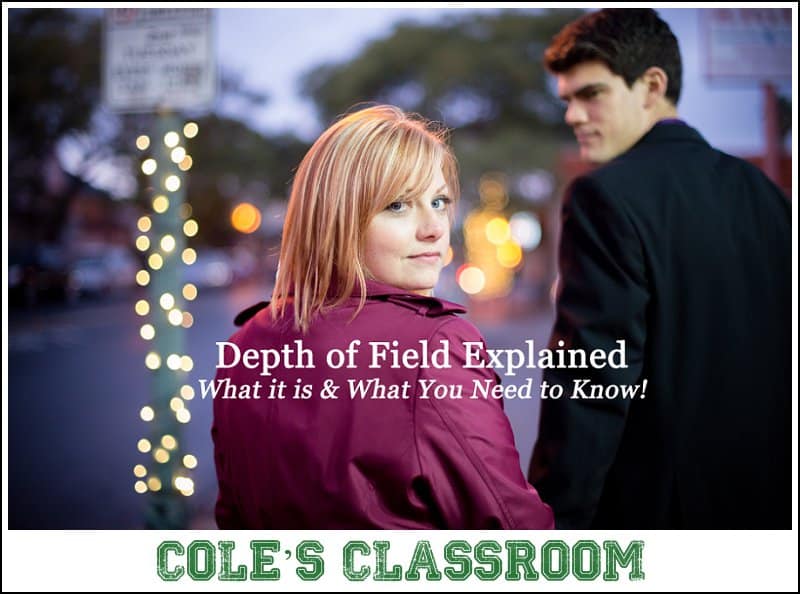What is Depth of Field?
Depth of field (DOF) is the distance between the nearest and farthest objects in a scene that appears acceptably sharp in an image. Depth of field refers to how acceptably sharp or blurry the area is around your subject. There’s a particular area in front of and behind the subject that will appear in focus.
In other words, depth of field refers to how much of the picture is in sharp focus relative to the out of focus areas of the image.
Lens aperture as well and lens focal length play a significant role in how much depth of field there is in a respective photo. Wider apertures have less depth of field (less in focus), a lens aperture that’s narrower will have a greater depth of field (more in focus).
Lenses with longer focal lengths offer greater compression to your images and have less depth of field while wider angle lenses and focal lengths give greater depth of field.
Here is an example demonstrating what depth of field is:
Focused on the pole, with 50 1.4 Lens. From left to right these photos were taken at – f/1.4, f/4 & f/16. Note: This is Depth of Field, how much of the “non-focused” areas are out of focused

Here are some common examples of when you’d want a shallow depth of field vs. having a lot of depth of field:
Shallow Depth of Field
A shallow depth of field usually comes from using a large aperture. Anything between f/1.2 and f/4.0 will separate the foreground from its background. You can use a shallow depth of field if the surroundings seem uninteresting, or you want to single out a point of interest.
A shallow depth of field is an excellent way to make your subject stand out from its surroundings. This is why depth of field is perfect for subject isolation, head-shots, portraits, to blur out “ugly” backgrounds, etc…
In low-light situations, like wildlife photography, you’ll need to increase the aperture to get more light. For sports images, you’ll want to separate the athlete from the background to bring attention to them. Such situations require you to use a fast enough shutter speed to gain a shallow DOF.
Broad Depth of Field
A small aperture results in a broader depth of field. Anything between f/8 to f/22 will let you take a shot where both the foreground and background look interesting.
A lot of depth of field is suitable for large group portraits, expansive landscapes, architecture, and any other time you want a large portion of the picture in focus.
In landscape photography, it’s important to put a long focus distance. Aside from using a shorter focal length to be further away from the subject, a smaller f-number will create a large depth of field. Aim to be under f/11 if you want some portion of your image to be blurred out.
Factors Affecting the Depth of Field
Aperture
Understanding depth of field and the role of the aperture in it is one of the first steps to becoming a better photographer. In relation to that, using the f-stop is the easiest way to control the depth of field.
Aperture refers to the opening in your camera lens that lets light pass through to the sensor. Think of it as the pupil — it dilates to let more light in, and contracts to restrict bright light.
The size of the aperture pertains to the diameter of the hole through which light enters the camera. This controls the amount of light that enters the lens. To help you recall the relationship between the two, here’s a simple equation:
Large aperture = Smaller f-number = Shallower depth of field
Small aperture = Larger f-number = Deep depth of field
Camera-Subject Distance
One of the factors that affect whether you have a deep depth of field or a shallow one is the distance between the subject and the camera. The closer the camera is to the subject, the greater the relative distance from the subject’s front and back.
The shorter the distance, the closer you are to the subject, and subsequently, the shorter the depth of field. Thus, moving further away from the subject will broaden the depth of field and make your shots appear sharper.
To change the camera-subject distance and control whether you have a deeper depth o field or not, all you have to do is to move away or move the tripod closer/farther away from the target.
Focal Length of the Lens
Focal length refers to the capacity of the lens to magnify the shot of a distant subject. In photography, the letter ‘f’ stands for the focal length of the lens. A large f or focal length means the lens allows you to select a focal point far in the distance.
Telephoto lenses with a longer focal length offer greater compression to your images and have less depth of field. Meanwhile, wider angle lenses and a wider focal length give greater depth of field.
Sensor Size
The sensor size of cameras is also crucial for you to control the depth of field. The size of the sensor varies between camera models.
In a nutshell, cameras with full-frame sensors obtain a lot of surface area while APS-C sensors have smaller surface areas. Hence, cameras with larger sensors will have a shallower depth of field, whereas smaller sensors will have a larger depth of field.
Determining Depth of Field
When you look through a camera’s viewfinder, you don’t actually see the scene exactly as it will look in your photographs. Since you’re viewing things live, you don’t see the implications of shutter speed, focal length and aperture in your images.
If you press the depth of field preview button while looking through the viewfinder, only then will the camera close down the aperture you’ve set, letting you see how the actual picture will look.
You can also use the live view to preview the DOF. If you’re using a mirrorless camera, what you see through the digital viewfinder or on the LCD is how the image will typically look.
Understanding the Circle of Confusion
The circle of confusion is another essential element when you’re understanding depth of field. It refers to the aperture values in which the lens can focus. Likewise, it’s the degree of tolerance that the human eye has before it distinguishes between an in-focus object and an out of focus object.
What is in or out of the circle of confusion is what you may define as the focus. This is why a picture appears in focus to the human eye, although, in reality, it may be slightly out of focus.
The best example of a circle of confusion in action is bokeh. When you open the aperture as wide as you can and focus on something, the out of focus lights expand and form ball-like shapes. This is the circle of confusion or the out of focus area.
Calculating the Depths of Field
Calculating depth of field using depth of field calculators is a useful way for assessing what camera settings you need to achieve your desired level of sharpness. This depends on the camera type, sensor or film size, selected aperture, lens focal length, and focus distance.
Using such details, the calculator will provide you with the nearest and furthest acceptable sharpness. However, you should not let all the numbers get in the way of your creativity. It still would be best to get a visual feel by manually setting your camera, then use the calculator to enhance the settings.
Controlling Depth of Field
While depth of field calculators help you figure out the exact depth of field, when you’re controlling depth of field you can achieve the same results by applying the following rules of thumb:
Control Depth of Field for Sharpness
To get your desired effect, you have three options to get a broader depth of field:
- High F-Stop Value: Open up the aperture as wide as possible, ideally f/2.8 or wider, to focus on the subject. Modify the shutter speed and ISO to achieve evenly-exposed images.
- Move Away from the Subject: Put a great distance and focal length between you and the subject to increase sharpness.
- Use a Lens With a Shorter Focal Length: Use a wide-angle lens with a shorter focal length to make the background more visible in the scene and maximize the depth of field to get the scene in focus.
Control Depth of Field for Blur
To get a shallower depth of field, you also have three ways:
- Low F-Stop Value: You can get a shallower depth of field using a smaller f-stop, like f/1.2 to f/2.0, to let in more light. Adjust the shutter speed and ISO to obtain proper exposure.
- Move Closer to the Subject: Use a telephoto lens or get physically closer to the subject. You may also place the subject as far away from the background as you can.
- Use a Lens With a Longer Focal Length: Use a telephoto lens with a longer focal length and manually select your focal point to be on the area of the subject you want the sharpest focus.
Now it’s your turn!
Go grab your camera with a favorite lens. Set your device on aperture priority mode and while having your camera on a tripod (if you need the stability, otherwise handheld is fine) take 3 photos, at the same lens focal length, at 3 different apertures. For best results take the photo where your subject or test object is far away from the background.
- Shot 1: At the widest aperture setting (f/1.8 if you have a 1.8 prime lens. Otherwise, aim for f/2.8)
- Shot 2: At f/5.6
- Shot 3: At f/22
What Are Your Results When Comparing the Different Photos?
The results should show you what exactly depth of field is as your subject and focus point should be in focus in ALL 3 photos, but, the background (non-focused areas) should be different levels of blur. The wide open aperture should give the most blurred background while the closed one should have much less background blur.
I hope this quick tutorial helped you unmask the mystery around what is depth of field and what you need to know about it.
Like the article about depth of field? Pin the top image to Pinterest!
Got any questions about depth of field, focal length or comments? Let me know in the comments below!
Talk soon!
Cole







